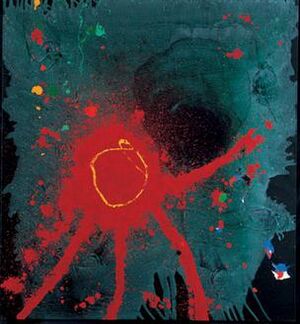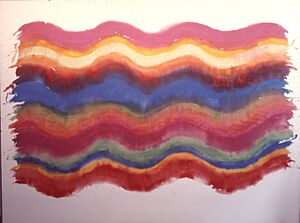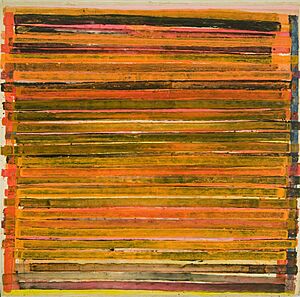Lyrical abstraction facts for kids
Lyrical Abstraction is a style of painting that appeared after World War II. It's known for its free and expressive use of paint, often showing the artist's feelings and energy. There are two main parts to this art style:
- European Lyrical Abstraction: This started in Paris, France, around 1947. It's often seen as part of a bigger art movement called Tachisme, which means "stain" or "blot" painting.
- American Lyrical Abstraction: This began in the United States in the late 1960s. It was a way for artists to move away from very strict, geometric art styles and return to more flowing, colorful painting.
Sometimes, "Lyrical Abstraction" is also used as a general term to describe abstract paintings that are similar to Abstract Expressionism, an art style popular in the 1940s. Many famous artists, like Arshile Gorky, created paintings that could be described as lyrical abstraction.

Contents
Where Lyrical Abstraction Began
After World War II, many artists in Europe, especially in Paris, started painting in a new way. This new style was called Abstraction lyrique. It was a fresh start for the art scene in Paris, which had been difficult during the war.
In 1947, an art critic named Jean José Marchand and a painter named Georges Mathieu gave the movement its name. Some people saw it as a way for Paris to show it was still a major center for art, even as the new New York School of Abstract Expressionism was becoming famous in the U.S. with artists like Jackson Pollock and Mark Rothko.
Lyrical Abstraction was different from earlier art styles like Cubism and Surrealism. It was also different from "cold abstraction," which used strict geometric shapes. Instead, Lyrical Abstraction allowed artists to express their personal feelings and ideas freely. It was inspired by the ideas of Wassily Kandinsky, who is considered one of the first abstract painters.
Later, in the late 1960s, many painters in the U.S. also started using more expressive painting styles. This was partly a reaction against very simple, minimalist art. Museums, like the Whitney Museum, officially recognized this return to expressive abstract painting as 'Lyrical Abstraction'.
European Abstraction Lyrique
After World War II, Paris became a hub for many artists from different countries. These artists, both young and old, worked and showed their art there. Some famous names included Nicolas de Staël, Serge Poliakoff, Hans Hartung, Wols, Sam Francis, and Paul Jenkins. French artists like Pierre Soulages and Georges Mathieu were also key figures.
This European Lyrical Abstraction was different from older styles like Cubism and Surrealism. It also stood apart from "geometric abstraction," which focused on sharp, clear shapes. For these artists, Lyrical Abstraction was about showing their inner feelings and thoughts. In Belgium, Louis Van Lint is a great example of an artist who moved into this lyrical style.
Many art shows took place in Paris galleries, like Arnaud and Drouin. At these shows, people could see the new lyrical abstract paintings. In 1951, a big exhibition called Véhémences confrontées (meaning "Confronted Vehemences") showed both French and American abstract artists together for the first time. This show helped declare that "lyrical abstraction is born."
However, this style was most popular for a short time, until about 1957. After that, new art movements like New Realism became more popular. But Lyrical Abstraction saw a comeback around 1970 with a new group of artists.
In 2006, a special exhibition in Paris called "The Lyrical Flight, Paris 1945–1956" featured works by 60 painters. It included important artists of the movement like Georges Mathieu, Pierre Soulages, and Zao Wou-Ki.
Artists in Paris (1945–1956) and beyond
- Geneviève Asse (1923–2021)
- Mino Argento (1927– )
- Jean René Bazaine (1904–2001)
- Roger Bissière (1888–1964)
- Albert Bitran (1931–2018)
- Norman Bluhm (1921–1999)
- Alexander Bogen (1916–2010)
- Camille Bryen (1907-1977)
- Jean-Michel Coulon (1920–2014)
- Olivier Debré (1920–1999)
- Piero Dorazio (1927–2005)
- Joe Downing (1925–2007)
- Jean Dubuffet (1901–1985)
- Endre Rozsda (1913–1999)
- Bracha Ettinger (1948– )
- Jean Fautrier (1898–1964)
- Pierre Fichet (1927–2007)
- Francois Fiedler (1921–2001)
- Sam Francis(1923–1994)
- Annick Gendron (1939–2008)
- Marc-Antoine Goulard (1964– )
- Hans Hartung (1904–1989)
- Simon Hantaï (1922–2008)
- Alexandre Istrati (1915–1991)
- Paul Jenkins (1923–2012)
- Antoni Karwowski (1948– )
- John Franklin Koenig (1924–2008)
- André Lanskoy (1902–1976)
- Alfred Manessier (1911–1993)
- René Marcil (1917–1993)
- Georges Mathieu (1921–2012)
- Jean Messagier (1920–1999)
- Jean Miotte (1926–2016)
- Joan Miró (1893–1983)
- Francis Picabia (1879–1953)
- Serge Poliakoff (1906–1969)
- Thibaut de Reimpré (1949– )
- Seund Ja Rhee (1918–2009)
- Jean-Paul Riopelle (1923–2002)
- Emilio Scanavino, (1922–1986)
- Vieira da Silva (1908–1992)
- Gustave Singier (1909–1984)
- Pierre Soulages (1919–2022)
- Nicolas de Staël (1914–1955)
- Yehezkel Streichman (1906–1993)
- Árpád Szenes (1897–1985)
- Gérard Ernest Schneider (1896–1986)
- Michel Tapié (1909–1987)
- Bram van Velde (1895–1981)
- François Willi Wendt (1909–1970)
- Wols, pseudonym of Alfred Otto Wolfgang Schulze (1913–1951)
- Zao Wou-Ki (1921–2013)
- Fahrelnissa Zeid (1901–1991)
Lyrical Abstraction in the United States

American Lyrical Abstraction started in cities like New York City and Los Angeles in the 1960s and 1970s. This style was a reaction against very strict art forms like minimalism and Pop Art. Artists wanted to paint more freely and expressively.
Paintings in this style often show:
- Loose and easy paint strokes.
- Spontaneous expression, meaning artists painted what they felt at the moment.
- The use of acrylic paints, sometimes stained onto the canvas.
- A focus on the "process" of painting itself.
This movement was similar in spirit to Abstract Expressionism and Color Field painting, as well as European Tachisme from the 1940s and 1950s.
The Sheldon Museum of Art held an exhibition in 1993 called Lyrical Abstraction: Color and Mood. It featured artists like Dan Christensen, Helen Frankenthaler, Sam Francis, and Ronnie Landfield. The museum explained that this movement continued the idea of post-war modern art. It was influenced by Jackson Pollock's "dripped painting" and Mark Rothko's large color areas. The goal was to create a direct, sensory experience of painting, making viewers "read" the paintings as objects themselves.
In 2009, the Boca Raton Museum of Art also had an exhibition called Expanding Boundaries: Lyrical Abstraction. They noted that Lyrical Abstraction came about after the challenges of Minimalism. Artists wanted to bring back a more painterly, romantic style to American art, focusing on line and color.
How the Term Started in America
The term "Lyrical Abstraction" became well-known in America because of an exhibition at the Whitney Museum of American Art in 1971. This show was first put together by Larry Aldrich, who founded the Aldrich Contemporary Art Museum in Connecticut.
In 1969, Larry Aldrich noticed a new trend in many artists' studios. He saw paintings that were moving away from geometric and minimal styles. Instead, they were more "lyrical, sensuous, romantic abstractions" with softer, more vibrant colors. He wrote that the artist's touch was always visible in these paintings, even when artists used tools like spray guns. Aldrich bought many of these paintings for his collection, and then he donated them to the Whitney Museum.
For a while, the term "Lyrical Abstraction" was sometimes used in a negative way. But later, art historians like Daniel Robbins said that the term should be used because it accurately describes a real return to expressive painting by artists across the country in the late 1960s.
Artists in America
Here is a list of artists whose work, or a part of it, is considered Lyrical Abstraction. Some of these artists were painting in this style even before the term became widely known in America in the 1960s.
|
|
|
How Lyrical Abstraction Connects to Other Art Styles

Lyrical Abstraction, along with movements like Fluxus and Postminimalism, aimed to expand what abstract painting could be. They focused on the "process" of creating art, using new materials and new ways to express ideas.
Lyrical Abstraction shares some similarities with Color Field painting and Abstract Expressionism. All three styles use paint in a free way, focusing on texture and surface. For example, a painting by Ronnie Landfield called For William Blake shows this. Artists might use direct drawing, bold lines, or techniques like brushing, splattering, or staining paint.
However, there are differences. In Action Painting (a part of Abstract Expressionism), there's a lot of focus on strong brushstrokes and dramatic compositions. Lyrical Abstraction, on the other hand, often has a more random, overall composition. It feels more relaxed and focuses on the process and repetition.
The differences with Color Field painting can be subtle because many Color Field artists, like Helen Frankenthaler and Jules Olitski, later developed styles that were similar to Lyrical Abstraction. Both Lyrical Abstraction and Color Field painting share a sense of spontaneous expression.
In the 1960s, English painter John Hoyland created Color field paintings with simple shapes and bright colors. Later, his paintings became more textured. His work was very similar to Post-painterly abstraction, Color Field painting, and Lyrical Abstraction.
Abstract Expressionism came before Lyrical Abstraction and other movements of the 1960s and 1970s, and it influenced them. During the mid-1960s, artists often blended different styles. This made American art, and art worldwide, very diverse and exciting.
See also
- Abstract expressionism
- Color field painting
- Hard-edge painting
- Post-painterly abstraction
- Tachisme
- COBRA (avant-garde movement)
- Formalism (art)
- Western painting
- History of painting
- Orphism (art)
- Nuagisme


